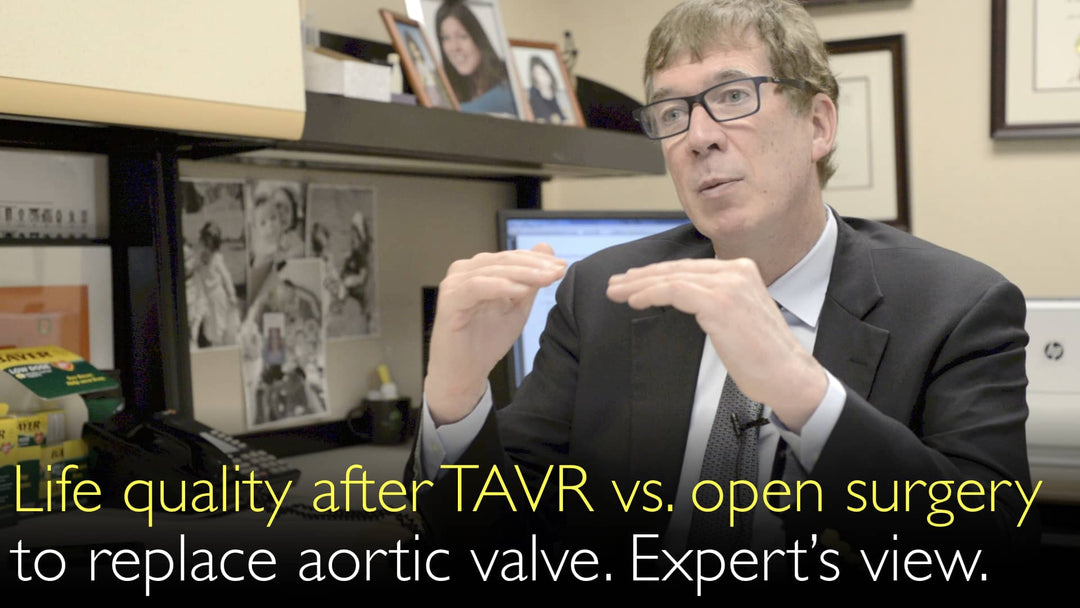Leading expert in transcatheter aortic valve replacement, Dr. Jeffrey Popma, MD, explains how patients feel 10 years younger after aortic valve replacement. He details the dramatic improvement in symptoms like shortness of breath and chest pain. Dr. Popma compares the recovery and long-term quality of life outcomes between TAVR and open-heart surgery.
Life After Aortic Valve Replacement: TAVR vs. Open Heart Surgery Outcomes
Jump To Section
- Symptom Relief and Quality of Life
- Feeling Younger After Valve Replacement
- Life Expectancy Benefits
- TAVR vs. Surgery Recovery
- Long-Term Quality of Life
- Full Transcript
Symptom Relief and Quality of Life
Elderly patients with severe aortic stenosis experience debilitating symptoms that severely impact their daily lives. Dr. Jeffrey Popma, MD, describes the classic symptoms as shortness of breath, chest pain, and lightheadedness. These symptoms prevent patients from performing simple activities like walking across a room or climbing stairs, stripping away their ability to enjoy life and attend family events.
Feeling Younger After Valve Replacement
Aortic valve replacement offers a profound transformation in how patients feel. Dr. Jeffrey Popma, MD, provides a powerful and understandable metric for this improvement. He states that on average, patients report feeling approximately ten years younger one year after their procedure. This means a 90-year-old patient can expect to feel like they are 80 again, a significant and laudable achievement in restoring vitality.
Life Expectancy Benefits
Beyond improving daily comfort, aortic valve replacement extends life. Dr. Jeffrey Popma, MD, highlights that the procedure offers an average of two to three additional years of life compared to medical therapy alone. This combination of increased lifespan and dramatically improved quality of life makes valve replacement a critical intervention for eligible patients with symptomatic aortic stenosis.
TAVR vs. Surgery Recovery
The recovery experience differs significantly between transcatheter aortic valve replacement (TAVR) and surgical aortic valve replacement (SAVR). Dr. Jeffrey Popma, MD, explains that the TAVR procedure, performed through the groin, allows for a faster initial recovery. In contrast, open-heart surgery requires a sternotomy and chest incision, leading to a slower and more painful early postoperative period. This difference is clearly reflected in quality-of-life metrics at the 30-day mark.
Long-Term Quality of Life
While early recovery favors TAVR, the long-term outcomes for both procedures are excellent and very similar. Dr. Jeffrey Popma, MD, notes that by six months, one year, and two years post-procedure, patients who had either TAVR or surgery report being significantly happier. Both groups experience that feeling of being ten years younger, with restored energy and freedom from the disabling symptoms of aortic stenosis. Dr. Anton Titov, MD, discusses these remarkable long-term benefits with Dr. Jeffrey Popma, MD.
Full Transcript
Dr. Anton Titov, MD: What to expect after TAVI or TAVR aortic valve replacement? Leading expert: "If you're 90, you're going to feel like you're 80." What quality of life could patients expect after a TAVI or TAVR procedure?
Dr. Jeffrey Popma, MD: It is a very interesting question. This is probably the most common question that our patients ask us. They have lived a great 80, 85, 90, or 95 years. In a couple of cases, patients are a hundred years old.
Yet now they are suffering from symptoms of aortic stenosis. This includes shortness of breath, chest pain, and lightheadedness. Patients with aortic stenosis sometimes have fatigue, but it is less common. All those symptoms impair their ability to enjoy life.
They can no longer walk across the room without being short of breath. They can't go up a flight of stairs. They can't go to their grandkids' soccer games because they are too short of breath.
Those sorts of things are quality-of-life issues more than quantity-of-life issues. What we know from all our studies is this: one year later after an aortic valve replacement procedure, patients feel much younger.
After surgical aortic valve or transcatheter aortic valve replacement, patients feel 10 years younger.
Dr. Anton Titov, MD: That is a great number, right?
Dr. Jeffrey Popma, MD: But that is the number that says if you are 90, you are going to feel like you are 80. If you are 95, you are going to feel like you are 85. For 80, you feel like you are 70. That is a very understandable comparison.
They are not going to feel like they are 50. But there is a very large number for patients. They feel like they did 10 years ago. That's a very laudable achievement.
On average, there is about a two- to three-year prolongation of life compared to medical therapy for aortic valve stenosis. At one year, the transcatheter aortic valves and the surgical valves look pretty good. They look pretty similar between the two options.
Dr. Anton Titov, MD: What's interesting is that the quality of life at the first month is different in patients who have a transcatheter aortic valve versus a surgical aortic valve.
Dr. Jeffrey Popma, MD: That is primarily because going from the groin rather than going from the open chest. The surgical recovery is slower, and the transcatheter recovery is a little bit faster.
We do quality-of-life metrics in patients after aortic valve replacement. We ask these questions: How do you feel? Are you moving around? What's your walk test? What's your KCCQ quality-of-life metrics?
Those are generally better in patients who have a transcatheter aortic valve replacement at 30 days compared to surgery. But by six months or one year or two years, everybody is a lot happier and feels a lot younger.




